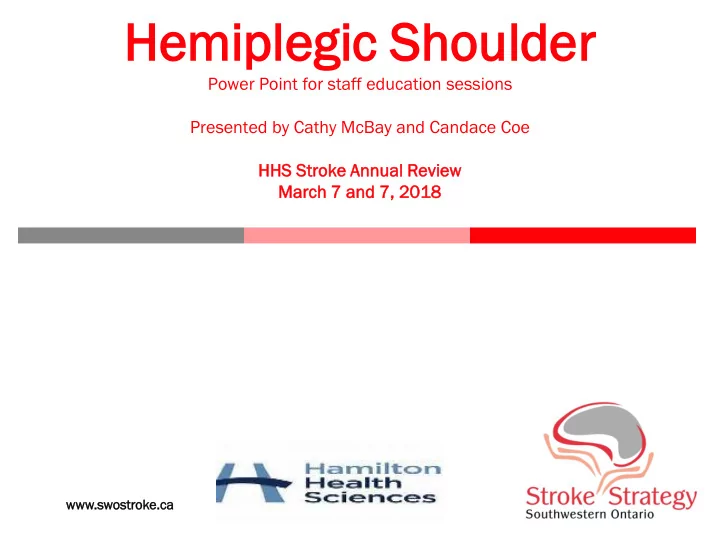

Hemip Hem iplegic legic Sh Shou oulder lder Power Point for staff education sessions Presented by Cathy McBay and Candace Coe HHS Stroke ke Annual al Review ew March h 7 and 7, 2018 www ww.s .swost ostroke.ca .ca
Overv verview iew • Structure of the Shoulder Complex • Low Tone Upper Limb • Hemi Arm protocol • High Tone Upper Limb • Hemiplegic Shoulder Pain
He Hemi mi Sli ling ng App pplicat lication ion
Str tructure ucture GLENOHUMERAL JOINT • Ball and socket joint. • Stability sacrificed for mobility. MUSCULAR CONTROL • Rotator Cuff muscles • Scapular and trunk muscles
Bio iomech mechanics: anics: Arm rm El Elevation evation • 0-90 degrees • Primarily arm (ie:humerus) movement • Little movement in shoulder blade (scapula) • Above 90 degrees • To allow normal movement and prevent impingement of rotator cuff tendons the shoulder blade MUST o Rotate up o Glide along rib cage
Low To Tone ne Sho houlder ulder • Most common in initial stages following stroke. • Results from damage to the motor pathways innervating the upper limb muscles. • Low tone shoulders are highly susceptible to damage of the structures surrounding the shoulder (muscles, tendons, ligaments). • Preventing subluxation is crucial in the early stages of stroke recovery- critical role for all team members
Low To Tone ne Sho houlder ulder • Pathoanatomy of Subluxed Shoulder • Flaccid or low tone muscles at shoulder and trunk lead to altered alignment of scapula and humerus. • Stabilizing muscles not present • Muscles overstretch due to weight of arm in dependent position. • Inferior subluxation is most common
Sho houlder ulder Sub ubluxat luxation ion • Consequences of shoulder subluxation: • Irreversible stretching of ligaments, tendons and capsule leading to instability at the joint. • Structural changes hamper recovery of muscle activity in shoulder complex. • Injury to brachial plexus. • Chronic shoulder pain.
Sho houlder ulder Sub ubluxat luxation ion
Managemen nagement t of Low w Tone e Shoulder ulder • Positioning • Support low tone arm at all times: o Use pillows, slings, lap trays o Slings should be worn during transfers or ambulation only. They should be removed during sitting or in bed. o In sitting, position shoulder in slight flexion, abduction and external rotation; forearm in pronation and hand in open weightbearing position. o Pay attention to position of pelvis and trunk alignment when sitting.
Sit itting ting In Wheel heelchair chair
Sit itting ting In n Bed ed
Ro Rolli lling ng to to He Hemi miplegic plegic Sid ide
Lyi ying ng On n He Hemi miplegic plegic Sid ide
Ro Rolli lling ng to to Un Unaffected affected Sid ide
Lyi ying ng on Unaf n Unaffect fected ed Sid ide
Managemen nagement t of th the Lo e Low w Tone ne Shoulder ulder • Handling…Be Gentle!! o Avoid lifting through underarm or pulling on arm to move patient. Instead grasp upper trunk near scapula to move the person. o Bed mobility: Hemi-arm out of way when rolling onto affected side. No pulling on hemi-arm when rolling onto unaffected side. o Support both the humerus and hand when moving the affected limb to position or dress patient. o Do not move arm beyond 90 degrees elevation. o Dressing sing Rule e for hemiplegia: “First on; last off”. • NOTE: Shoulder pain occurs more frequently in patients who are dependent for transfers.
Th The e He Hemi miplegic plegic Arm rm Pr Protocol otocol Hemiplegic Shoulder Best Practice Positioning And Handling Protocol
Objective bjective The hemiplegic upper extremity will be protected from injury by being properly handled during mobility and transfers and properly positioned in bed or wheelchair, according to the positioning protocol diagrams for all patients meeting the criteria for the protocol.
Incl nclusion usion Criteria riteria • Hemiplegic arm is flaccid. • And/or patient is unable to lift arm off bed to 90 ° . • And/or the arm is painful.
Pr Procedure ocedure • OT/PT assesses patients for protocol inclusion criteria • All disciplines adhere to implementation of the protocol • Patients meeting criteria will receive: • A hemi sling at bedside • Hemi sling application directions posted at bedside
Hi High gh To Tone ne Up Upper per Lim imb Frequently occurs later post stroke. Natural recovery may include high tone as a temporary phase or a permanent consequence. Good early management of possible severe long term consequences is important. High muscle tone or spasticity: • increased state of excitability of muscle stretch reflexes. • Speed and position dependent. • Stiffness, spasms
Hi High gh To Tone ne Up Upper per Lim imb Consequences of high tone: • Impaired skin care (axilla and hand) Impaired ADLs (dressing) • • Impaired range of motion: permanent contracture • Shoulder pain
Hi High gh To Tone ne Up Upper per Lim imb • “Flexor Pattern”
Managemen nagement t of th the Hi e High gh Tone e Upp pper er Limb mb • Positioning • Promote position that is opposite to flexor pattern • Position for extended periods of time (up to 1 hour or more) to promote lengthening of the tight muscles • Use pillows, airsplints, thermoplastic splints or casting as required • Consider a referral to the Spasticity Management Clinic: a team of a Physiatrist, RN, and OT/PT can facilitate pharmaceutical (BOTOX) treatment, splinting etc.
He Hemiplegic miplegic Sho houlder ulder Pa Pain in • Incidence of Shoulder Pain • Up to 1/3 of adult stroke patients within the first year • Signs and Symptoms • Pain located in shoulder, may radiate down arm. • Pain worse with movement especially external rotation, abduction and flexion of GH joint. • Pain may be present constantly and interfere with sleep.
Questions? uestions?
Recommend
More recommend